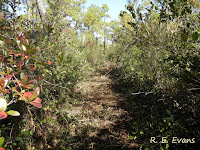 |
| Longleaf pine stand and prescribed burn near the coast of North Carolina; flame lengths and intensity are greater than many managers would prefer |
 |
| Longleaf "flattop"; these trees often represent remnants of earlier forests skipped over by loggers |

Mechanically reducing the fuels in such stands can help protect high-value individual trees and lower overall fire intensity. However, doing so across large and heavily overgrown stands takes a concerted approach. Several years ago, we stepped up and took one (a concerted approach, that is).
 |
| The "concerted approach"! Skid steer equipped with forestry cutter |
We acquired a skid steer equipped with tracks to minimize ground disturbance, a special cab to protect the operator, and a "forestry cutter". Examples of how we used it are shown below:
 |
| Disappearing mower and mowed swath through heavy "bay" fuels Brunswick Co, NC |
 |
| Mower headed straight toward remnant longleaf pine, barely evident from a distance due to tall shrub and Pond Pine (Pinus serotina) encroachment |
In these circumstances it was the perfect way to go "looking for longleaf".
The images below show this stand before and after treatment. Note the lone Longleaf pine with the Y-shaped canopy near the center. Amazingly, a young longleaf pine was hiding in the dense brush immediately in front of this tree (click & enlarge image right). After clearing, the stand displayed the open structure typically associated with longleaf pine savannas and woodlands - a restoration success?. Comment appreciated!
 |
| Longleaf pine stand with relicts, after mulching treatment (same stand as above) Note - turpentine faces on 2 of the trees. Brunswick Co, N.C. |



Restoring longleaf pine ecosystems is such an important conservation effort, and the use of controlled fire is fascinating! A tracked skid loader can be a valuable tool in preparing the land for restoration, ensuring efficiency and care in sensitive environments. For reliable equipment, check out SEA LION INTERNATIONAL TRADE CO., Ltd.!
ReplyDeleteFire restoration services help recover your property after unexpected damage.From smoke and soot removal to structural repairs, experts handle it all with care.Professional support ensures safety, comfort, and peace of mind during recovery.
ReplyDeleteFire restoration services